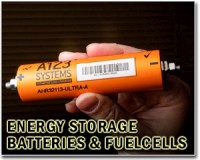 |
San Jose, California (AFP) Feb 24, 2010 Stealth start-up Bloom Energy on Wednesday publicly unveiled an innovative fuel cell that promises to deliver affordable, clean energy to even remote corners of the world. Compact Bloom Servers built with energy cells made from silicon -- a plentiful element found in sand -- made their formal debut in an eBay building here partially powered by the energy source. "Bloom fuel cell technology has the potential to revolutionize the energy industry," California governor Arnold Schwarzenegger said while introducing Bloom founder K.R. Sridhar. "He is someone shaping the future of energy not just for California but for the world," Schwarzenegger said. A high-powered audience gathered for the event included Google co-founder Larry Page, eBay chief executive John Donahoe and former US secretaries of state George Shultz and Colin Powell. "The core of our technology simply is sand," Sridhar said pulling a black cloth off a clear glass container of sand and then holding up a greeting-card sized cell made from the material. "It is available in plenty... and it has the scientific property that enabled us to make a fuel cell," he said. Fuel cell technology dates back to the mid 1800s, but Bloom eliminated the need for expensive metals such as platinum. Bloom servers work with a variety of fuels, meaning users can freely switch to whatever is locally available or most affordable, according to Sridhar. "Basically, if it has a hydrogen or a carbon in it, or both, the cell is capable of using it as fuel," Bloom marketing vice president Stu Aaron told AFP. "We have run it in the lab on vodka, although we don't recommend that. There are better uses for vodka." The fuel cells use electrochemical reactions instead of combustion. Liquid or gas fuels go into the cell and electricity comes out, according to Aaron. Fuel and air pass over opposite sides of cells, which trigger oxygen ions to combine with the fuel to produce electricity, heat, water and an oxide based on the chemicals in the mix. In the case of natural gas, propane or bio-gases with hydrogen, the oxide by-product is water. The cells reuse heat and water to sustain the process. If the cells were operating on oil, gasified coal or other fossil fuels a byproduct would be carbon dioxide, but in amounts two-thirds less than given off by burning, according to Bloom. "In Africa it could be ethanol from switch grass; in California it could be cow manure," Aaron said. "The beauty of the technology is that it can be deployed anywhere and use the local resources that are most economical and clean." The servers, nicknamed "Bloom boxes," have been secretly tested by a group of major corporations including eBay, Wal-Mart, and Coca Cola. Google was Bloom's first customer, buying four servers that it installed at its campus in Mountain View, California. "I'm a big supporter of this," Page said during an on-stage chat with renowned Silicon Valley venture capitalist John Doerr of Kleiner Perkins Caulfield & Byers, a major backer of Bloom. "I'd love to see us have a whole data center running on this at some point when they are ready," Page said. Bloom servers capable of pumping out 100 kilowatts of electricity each cost 700,000 to 800,000 dollars but the price is expected to plummet as production ramps up and efficiencies of scale are achieved. Sridhar predicted it will take about a decade for the technology to get to the point where it can be used in homes. He hefted a brick-sized fuel cell in one hand, saying it could power a standard light bulb but will soon be able to satisfy the electricity needs of a typical US home. Electricity generated by Bloom servers -- refrigerator-sized metal boxes housing stacks of fuel cells -- costs about nine cents per kilowatt/hour as opposed to the 14 or 15 cents typically charged here by utilities. The cost of the servers is recovered in three to five years by energy savings, according to Sridhar. The servers are guaranteed for 10 years. Sridhar would not disclose the lifespans of the fuel cells. Colin Powell, a Bloom board member and retired general, said the servers could be a boon to the military, which has grown increasingly energy-dependent as technology infuses the tools of war. "This is a breakthrough," Powell said. "Sooner or later it is going to be in homes all across America. Think what it will ultimately do for humankind."
Share This Article With Planet Earth
Related Links Powering The World in the 21st Century at Energy-Daily.com
 Bloom Energy unveils fuel cell of the future
Bloom Energy unveils fuel cell of the futureSan Jose, California (AFP) Feb 24, 2010 Stealth start-up Bloom Energy on Wednesday publicly unveiled an innovative fuel cell that promises to deliver affordable, clean energy to even remote corners of the world. Compact Bloom Servers built with energy cells made from silicon - a plentiful element found in sand - made their formal debut in an eBay building here partially powered by the energy source. "Bloom fuel cell technolo ... read more |
|
| The content herein, unless otherwise known to be public domain, are Copyright 1995-2010 - SpaceDaily. AFP and UPI Wire Stories are copyright Agence France-Presse and United Press International. ESA Portal Reports are copyright European Space Agency. All NASA sourced material is public domain. Additional copyrights may apply in whole or part to other bona fide parties. Advertising does not imply endorsement,agreement or approval of any opinions, statements or information provided by SpaceDaily on any Web page published or hosted by SpaceDaily. Privacy Statement |